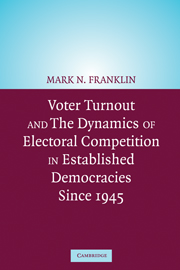Book contents
- Frontmatter
- Contents
- Figures
- Tables
- Preface
- The Authors
- Introduction
- 1 Confronting the Puzzles of Voter Turnout
- 2 A New Approach to the Calculus of Voting
- 3 The Role of Generational Replacement in Turnout Change
- 4 Rational Responses to Electoral Competition
- 5 Explaining Turnout Change in Twenty-Two Countries
- 6 The Character of Elections and the Individual Citizen
- 7 Understanding Turnout Decline
- 8 The Turnout Puzzles Revisited
- APPENDICES
- Bibliography
- Author Index
- Subject Index
Preface
Published online by Cambridge University Press: 08 February 2010
- Frontmatter
- Contents
- Figures
- Tables
- Preface
- The Authors
- Introduction
- 1 Confronting the Puzzles of Voter Turnout
- 2 A New Approach to the Calculus of Voting
- 3 The Role of Generational Replacement in Turnout Change
- 4 Rational Responses to Electoral Competition
- 5 Explaining Turnout Change in Twenty-Two Countries
- 6 The Character of Elections and the Individual Citizen
- 7 Understanding Turnout Decline
- 8 The Turnout Puzzles Revisited
- APPENDICES
- Bibliography
- Author Index
- Subject Index
Summary
Human beings, it has been suggested, have a “puzzle instinct” (Danesi 2002) – a fascination with puzzles and an aptitude for solving them. Academic research in most disciplines is all about puzzle-solving, but political science is perhaps unusual in being home to a great many puzzles that are of interest beyond the walls of academe. Bernard Grofman recently edited a book with the title Political Science as Puzzle-Solving (2001) whose premise was that interesting puzzles lead us to topics where the tools and skills of political science can be brought to bear, teaching us useful things about the world.
If the vexing questions of political science can be regarded as puzzles, the particular topic of voter turnout could be called the “grand enchilada” of puzzles in political science. As we will see in Chapter 1, almost everything about voter turnout is puzzling, from the question of why anyone bothers to vote at all to the question of why certain variables appear to explain voter turnout in some circumstances but not in others.
I became interested in these puzzles in the early 1990s as a by-product of my interest in elections to the European Parliament. Turnout in these elections is very low despite the fact that they occur in countries (of the European Union) where turnout levels in national elections are generally high.
- Type
- Chapter
- Information
- Voter Turnout and the Dynamics of Electoral Competition in Established Democracies since 1945 , pp. xi - xivPublisher: Cambridge University PressPrint publication year: 2004

